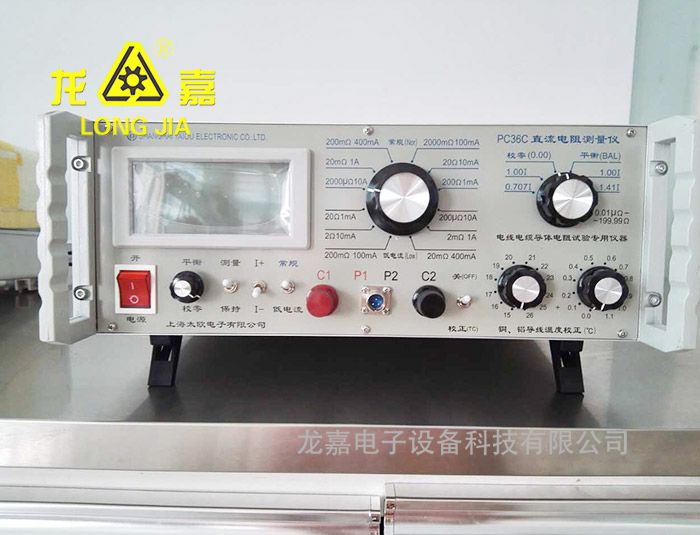The DC resistance test of the transformer winding is an indispensable test item for the transformer after the handover, overhaul and change of the tap changer. Under normal circumstances, measuring the DC windings of transformer windings and high-power inductive devices by conventional methods (bridge method and voltage drop method) is a time-consuming and labor-intensive task. In order to change this situation, shorten the measurement time and reduce the workload of testers, resistance test instrument manufacturer has produced DC resistance measuring meter. It adopts new power supply technology, featuring stable performance, rapid measurement, small size, convenient use, high measurement accuracy and good data repeatability. It is ideal for measuring transformer windings and DC resistance of high power inductive devices. ,
The DC resistance measurement method
1. DC balanced bridge
a) DC single arm bridge (Wheatstone bridge)
The main feature of the DC single-arm bridge is high sensitivity, which can obtain highly accurate measurement results and is suitable for measuring 1~99990Ω. It is a kind of comparison instrument and can't read directly. When the bridge is balanced, the measurement result is calculated by the formula Rx = (R2/R3)*R1. In the formula, Rx is the measured resistance, R1/R2 is the proportional arm, and R3 is Compare the arms.
The DC resistance tester measurement steps are as follows:
1. Turn the lock of the galvanometer (from the inside out) and adjust the zero to zero the pointer.
2. Connect the resistor under test to the “Rx” position.
3. It is required to use thicker and shorter wires, and scrape the paint film, tighten the joints, and avoid the use of wire clamps, because the poor contact of the joints will make the balance of the bridge unstable, and the detector needle may be damaged in severe cases.
4. Estimate the size of the measured resistance and select the appropriate bridge arm ratio so that the fourth arm of the comparison arm can be fully used. This makes it easy to adjust the bridge to balance and guarantee the 4 significant digits of the measurement result.
5. Loosen the lock knob of the galvanometer, first press the power button B and lock it, then press the galvanometer button G (click).
6. Adjust the comparator arm resistance so that the galvanometer points to zero and the bridge is balanced. If the pointer refers to "+", then the comparison arm resistance needs to be increased. When the pointer points to "-", the comparison arm resistance needs to be reduced, and the adjustment is repeated until the galvanometer reaches the zero position.
7. Read the value of the 4 reading discs of the comparison arm and obtain the measured resistance value according to the formula Rx=R1*(R2/R3).
8. After the measurement is completed, first disconnect the galvanometer button, then disconnect the voltage button, then disassemble the measured resistance, and then lock the galvanometer lock to prevent damage to the galvanometer during the moving process.
Things to be aware of when using a single-arm bridge:
1. According to the university and the measurement error requirements of the measured resistance value, select the corresponding proportional arm (magnification) according to the specifications in the instruction manual.
2. Insufficient battery voltage will affect the sensitivity of the bridge, so if the battery voltage is found to be insufficient, it should be exchanged. When using an external power supply, you must pay attention to the polarity, and do not make the voltage exceed the specified value, otherwise the bridge arm resistance may be burned out. In this case, an adjustable protection resistor can be connected in series in the power supply circuit to reduce the voltage.
3. The connecting wire between the measuring end and the measured resistance should be as short and thick as possible. The connection should be firm and the paint film should be scraped. Avoid using the wire clamp to improve the measurement accuracy.
4. When measuring the resistance with inductance (such as the resistance of the motor or transformer winding), first turn on the power, then press the galvanometer button. When disconnecting, first disconnect the galvanometer button, then disconnect the power supply to avoid The self-inductive electromotive force of the coil destroys the galvanometer.
5. When the bridge is not in use, lock the galvanometer and short the inner and middle binding posts to avoid breaking the suspension wire when moving.
6. During the adjustment of the comparator arm resistance, when the bridge is not near equilibrium, the current flowing through the galvanometer may be large, and the galvanometer button should be released. Only after each adjustment, press the button for a short time to protect the galvanometer from damage.
7. When measuring a device with a capacitor, discharge it before measuring.

Xingtai Longjia Electronics Technology Co.,Ltd.
Copyright © Xingtai Longjia Electronics Technology Co.,Ltd. All Rights Reserved | Sitemap |Powered by 
